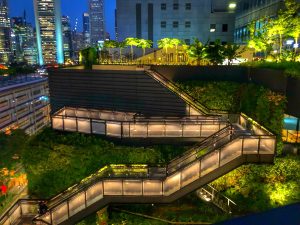
Urban farming and gardening are becoming increasingly popular as cities worldwide look for ways to adapt to the changing climate and promote sustainable living. With the growing trend of urbanization, the need for sustainable and efficient food production is becoming increasingly important, and urban farming and gardening provide a unique solution to this problem. In this article, we’ll look at the various adaptation options available for urban farming and gardening and their importance in the current climate scenario.
Staircase view of the urban farm from afarThe Benefits of Urban Farming and Gardening
Urban farming and gardening offer a wide range of benefits to the environment and local communities. These benefits include:
- Increased food security: By growing their food, urban residents can reduce their dependence on imported food, which can be costly and unreliable.
- Improved air quality: Plants absorb carbon dioxide and other pollutants, making urban areas greener and healthier.
- Reduced waste: Composting and vermicomposting can turn food waste into valuable fertilizer, reducing the amount of waste that goes to landfills.
- Improved community cohesion: Urban farming and gardening can unite people, encouraging them to work and learn from each other.
Types of Urban Farming and Gardening
There are several different types of urban farming and gardening, each with unique benefits and challenges. Some of the most popular forms of urban agriculture and gardening include:
- Community gardens are shared spaces where residents can gather food and flowers. These gardens can be located in public areas like parks or private land.
- Rooftop gardens: Rooftop gardens are a great way to use unused space on top of buildings. They provide a unique environment for growing plants and can help reduce the heat absorbed by structures.
- Vertical gardens: Vertical gardens are a space-saving solution for urban areas, allowing for the maximum use of limited space. They can be used to grow various plants, including vegetables and herbs.
- Container gardens: Container gardens are ideal for small spaces, such as balconies and patios. They can be used to grow various plants, including vegetables and herbs.
The Challenges of Urban Farming and Gardening
Despite the many benefits of urban farming and gardening, several challenges must be overcome. Some of the most common challenges include:
- Lack of space: Urban areas are often densely populated, making finding space for gardens and farms difficult.
- Lack of sunlight: Many urban areas are shaded by buildings, making it difficult for plants to grow.
- Water scarcity: Urban areas often have limited access to water, making it challenging to keep plants hydrated.
- Soil quality: The soil in urban areas is often contaminated with pollutants, making it unsuitable for growing food.
Best Practices for Urban Farming and Gardening
To overcome these challenges and ensure the success of urban farming and gardening, it’s essential to follow best practices. Some of the best practices include:
- Choose the right plants: Choose plants that are well-suited to the environment, such as those that are drought-resistant and can thrive in low-light conditions.
- Use compost and vermicompost: Compost and vermicompost can help to improve soil quality and fertility, making it easier for plants to grow.
- Implement efficient water use: Drip irrigation and other techniques to conserve water and reduce waste.
- Use sustainable materials: Use sustainable materials, such as recycled and reusable containers, to reduce waste and promote sustainability.
- Incorporate community involvement: Encourage community involvement by offering workshops and educational programs and involving residents in planning and maintaining urban farms and gardens.
The Future of Urban Farming and Gardening
As the world continues to face the impacts of climate change, the need for sustainable and efficient food production will only become more pressing. Urban farming and gardening solve this problem, and their popularity is likely to continue to grow in the coming years.
Advances in technology, such as vertical farming and hydroponics, will likely shape the future of urban farming and gardening. These technologies will produce more efficient and sustainable food, even in the most densely populated urban areas.
Additionally, there may be increased investment in urban farming and gardening initiatives as governments and corporations recognize their benefits. This could lead to more community gardens, rooftop gardens, and vertical farms, as well as the development of new technologies and approaches to urban agriculture.
Final Thoughts
Urban farming and gardening are crucial to adapting to the changing climate and promoting sustainable living in urban areas. By following best practices, overcoming challenges, and embracing new technologies, urban farming and gardening can create a more sustainable and resilient urban environment. Whether you’re an urban resident looking to grow your food or a government or corporation looking to invest in sustainable food production, urban farming and gardening offer a unique and valuable solution.